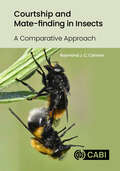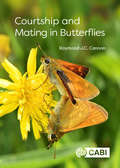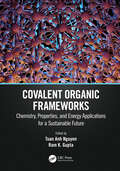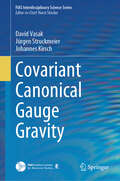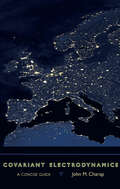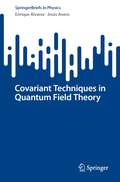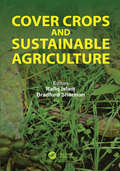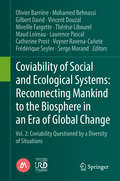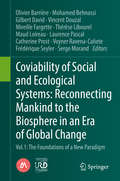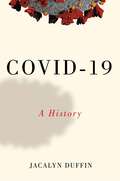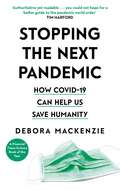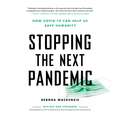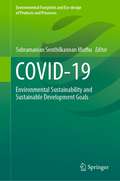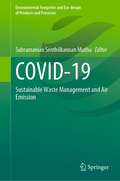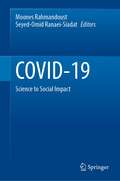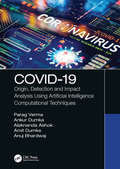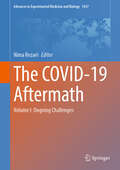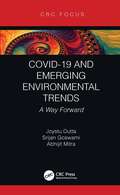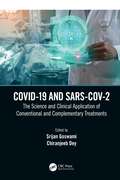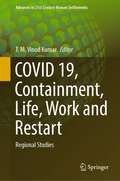- Table View
- List View
Courtship and Mate-finding in Insects: A Comparative Approach
by Raymond J CannonThis book explores mate-finding and courtship behaviour in the insect world, in all its subtlety and diversity. Insects engage in courtship as much, or as little, as any other animal; they have songs and dances, and all manner of instruments and ornaments to attract and court the opposite sex. Insects have evolved complex chemical and acoustic communication systems, sending fragrant messages, visual signals and subtle vibrations to attract and persuade. Insects also have many different ways and means of choosing or rejecting mating partners. This beautifully illustrated book shows the incredible variety of courtship behaviours and celebrates the wonderful natural history of a wide range of insects. Varieties of courtship can occur before, during and even after copulation, and numerous examples of the different mating strategies used are presented. As well as being fascinating and entertaining, studying courtship is also useful. For example, a knowledge of the courtship and mating behaviour of important pests helps researchers understand the dynamics of mate choice and sexual selection. Knowing which behaviours are directly related with mating success can be used to improve behaviour-based control strategies and improve sterile insect techniques. Knowledge of sex pheromones, and mating behaviour, can be combined to manage insect pests by mass or mating disruption. By studying model species - such as the fruit fly, Drosophila melanogaster - researchers have discovered how genes control and influence courtship behaviour, via proteins, biochemical pathways and neural circuits. This book integrates these diverse fields into a framework constructed around courtship and mate-finding, bringing together studies from the laboratory and the field. This landmark volume will be of interest to students of biology, entomologists, naturalists and anyone with a desire to know more about the love lives of the small creatures with which we share the planet.
Courtship and Mating in Butterflies
by Raymond J.C. CannonThis book presents a readable account of butterfly behaviour, based on field observations, great photographs and the latest research. The main focus is on courtship and mating - including perching, searching and territorial behaviour - but to understand these subjects it is necessary to explain how mates are chosen and this requires sections on wing colours and patterns. A chapter on butterfly vision is also essential in terms of how butterflies see the world and each other. There have been exciting discoveries in all of these fields in recent years, including: butterfly vision (butterfly photoreceptors), wing patterns (molecular biology), wing colouration (structural colours and nano-architecture), mating strategies and female choice (ecology and behaviour).
Cousteau
by Axel MadsenOne of the most influential men of the twentieth century, Jacques Cousteau was an eco-emissary whose own life of derring-do brought him fame and the means to proselytize his cause. Ecologist, adventurer, celebrity, businessman--Cousteau was a brilliant and complex individual, and Madsen's biography captures him in style. Madsen, who knew the Cousteau family for over two decades, interviewed Cousteau personally for this book.
Covalent Organic Frameworks: Chemistry, Properties, and Energy Applications for a Sustainable Future
by Tuan Anh Nguyen Ram K. GuptaCovalent organic frameworks-based nanomaterials have emerged as promising candidates for energy applications owing to their superior electrochemical properties, surface area, nano-device integration, multifunctionality, printability, and mechanical flexibility. This book provides fundamentals, various synthesis approaches, and applications of covalent organic frameworks-based nanomaterials and their composites for generating energy. The main objective of this book is to provide current, state-of-the-art knowledge about covalent organic frameworks-based nanomaterials and their composites for supercapacitors, batteries, photovoltaics, and fuel cells, covering almost the entire spectrum in the energy field under one title. Aimed at widening our fundamental understanding of covalent organic frameworks and mechanisms for realization and advancement in devices with improved energy efficiency and high storage capacity, this book will provide new directions for scientists, researchers, and students to better understand the principles, technologies, and applications of covalent organic frameworks.
Covariant Canonical Gauge Gravity (FIAS Interdisciplinary Science Series)
by David Vasak Jürgen Struckmeier Johannes KirschThis book starts with the mathematical basis of the theory - i.e. provide a brief sketch of the theory of manifolds and frame bundles, tensors and their transformations, relativistic kinematics, and aspects of non-flat space-time geometries. The definition of relevant physical quantities (torsion, curvature, non-metricity, tetrads, connection fields etc.) and important geometry concepts are also included. The main body of the book is devoted to a detailed derivation of the gauge theory of gravitation for scalar, vector (Proca and Maxwell) and Dirac spinor fields. Alternative approaches based on the Noether theorem and on the spinorial representation of the fields are also addressed, as well as important novel features related to the CCGG framework (Birkhoff theorem, field derivative identities etc.). In the last section of the volume the application of the CCGG theory to cosmology will be set out, resulting in a new understanding of dark energy and inflation.
Covariant Electrodynamics: A Concise Guide
by John M. CharapA notoriously difficult subject, covariant electrodynamics is nonetheless vital for understanding relativistic field theory. John M. Charap’s classroom-tested introduction to the mathematical foundations of the topic presents the material in an approachable manner.Charap begins with a historical overview of electrodynamics and a discussion of the preliminary mathematics one needs in order to grasp the advanced and abstract concepts underlying the theory. He walks the reader through Maxwell’s four equations, explaining how they were developed and demonstrating how they are applied. From there, Charap moves through the other components of electrodynamics, such as Lorentz transformations, tensors, and charged particle behavior. At each point, he carefully works through the mathematics, applies the concepts to simple physical systems, and provides historical context that makes clear the connections among the theories and the mathematicians responsible for developing them. A concluding chapter reviews the history of electrodynamics and points the way for independent testing of the theory.Thorough, evenly paced, and intuitive, this friendly introduction to high-level covariant electrodynamics is a handy and helpful addition to any physicist’s toolkit.
Covariant Loop Quantum Gravity
by Carlo Rovelli Francesca VidottoQuantum gravity is among the most fascinating problems in physics. It modifies our understanding of time, space and matter. The recent development of the loop approach has allowed us to explore domains ranging from black hole thermodynamics to the early Universe. This book provides readers with a simple introduction to loop quantum gravity, centred on its covariant approach. It focuses on the physical and conceptual aspects of the problem and includes the background material needed to enter this lively domain of research, making it ideal for researchers and graduate students. Topics covered include quanta of space; classical and quantum physics without time; tetrad formalism; Holst action; lattice QCD; Regge calculus; ADM and Ashtekar variables; Ponzano-Regge and Turaev-Viro amplitudes; kinematics and dynamics of 4D Lorentzian quantum gravity; spectrum of area and volume; coherent states; classical limit; matter couplings; graviton propagator; spinfoam cosmology and black hole thermodynamics.
Covariant Techniques in Quantum Field Theory (SpringerBriefs in Physics)
by Enrique Álvarez Jesús AneroThe purpose of this book is to illustrate some of the most important techniques which are helpful in combinatorial problems when computing quantum effects in covariant theories, like general relativity. In fact, most of the techniques find application also in broader contexts, such as low energy effective (chiral) Lagrangians or even in specific problems in condensed matter. Some of the topics covered are: the background field approach and the heat kernel ideas. The arguments are explained in some detail and the presentation is meant for young researchers and advanced students who are starting working in the field. As prerequisite the reader should have attended a course in quantum field theory including Feynman’s path integral. In the Appendix a nontrivial calculation of one-loop divergences in Einstein-Hilbert gravity is explained step-by-step.
Cover Crops and Sustainable Agriculture
by Rafiq Islam and Bradford ShermanThis book will not serve as the "encyclopedia of cover crop management," but it’s close. The benefits of a wide range of individual cover crops and blends/mixes for specific agronomic crop rotations and geographic locations are included. Descriptions, photographs, and illustrations show how cover crops look in the field, including plant height, leaf architecture, and rooting patterns. Long term benefits are described for soil health, soil structure, water quality, nutrient contributions, soil biodiversity, air quality and climate change. In addition to the "whys" of cover crop use, the book includes details on the "hows:" how to choose cover crops for specific applications and locations; how (and when) to plant; how to manage and maintain the cover for maximum benefit; and how and when to terminate. Planting options include: drilling/planting between rows of an agronomic crop at planting time, or when the crop is short (i.e. corn in early June); "aerial" seeding with an airplane or high-clearance machine shortly before the crop reaches maturity; and drilling/planting immediately after harvest of the agronomic crop. Selected cover crops (blends) can help with pest and disease management. Cover crops are an economic input with an expected return on investment, similar to pesticides and fertilizer. As part of a continuous no-till system, cover crops provide long-term biological, chemical and structural benefits. The resulting increase in soil organic matter means the agronomic crop yields benefit from better water infiltration and water holding capacity, greater availability of nitrogen and other nutrients, deeper rooting, and increased soil microbial activity in the root zone.
Covering and Surrounding: Two-Dimensional Measurement
by Glenda Lappan Elizabeth Difanis Phillips James T. Fey Susan N. FrielNIMAC-sourced textbook
Covering and Surrounding, Two-Dimensional Measurement
by Glenda Lappan James T. Fey William M. FitzgeraldNIMAC-sourced textbook
Coviability of Social and Ecological Systems: Reconnecting Mankind To The Biosphere In An Era Of Global Change Vol. 1 : The Foundations Of A New Paradigm
by Olivier Barrière Mohamed Behnassi Gilbert David Vincent Douzal Mireille Fargette Thérèse Libourel Maud Loireau Laurence Pascal Catherine Prost Voyner Ravena-Cañete Frédérique Seyler Serge MorandThis second volume is the work of more than 55 authors from 15 different disciplines and includes complex systems science which studies the viability of components, and also the study of empirical situations. As readers will discover, the coviability of social and ecological systems is based on the contradiction between humanity, which adopts finalized objectives, and the biosphere, which refers to a ecological functions. We see how concrete situations shed light on the coviability’s determinants, and in this book the very nature of the coviability, presented as a concept-paradigm, is defined in a transversal and ontological ways. <P><P> By adopting a systemic approach, without advocating any economic dogma (such as development) or dichotomizing between humans and nature, while emphasizing what is relevant to humans and what is not, this work neutrally contextualizes man’s place in the biosphere. It offers a new mode of thinking and positioning of the ecological imperative, and will appeal to all those working with social and ecological systems.
Coviability of Social and Ecological Systems: Reconnecting Mankind To The Biosphere In An Era Of Global Change Vol. 1 : The Foundations Of A New Paradigm
by Serge Morand Mohamed Behnassi Olivier Barrière Gilbert David Vincent Douzal Mireille Fargette Thérèse Libourel Maud Loireau Laurence Pascal Catherine Prost Voyner Ravena-Cañete Frédérique SeylerThis book considers the principle of ‘sustainable development’ which is currently facing a growing environmental crisis. A new mode of thinking and positioning the ecological imperative is the major input of this volume. The prism of co-viability is not the economics of political agencies that carry the ideology of the dominant/conventional economic schools, but rather an opening of innovation perspectives through science. This volume, through its four parts, more than 40 chapters and a hundred authors, gives birth to a paradigm which crystallizes within a concept that will support in overcoming the ecological emergency deadlock.
COVID-19: A History (Canadian Essentials)
by Jacalyn DuffinFor two years the COVID-19 pandemic has upended the world. The physician and medical historian Jacalyn Duffin presents a global history of the virus, with a focus on Canada.Duffin describes the frightening appearance of the virus and its identification by scientists in China; subsequent outbreaks on cruise ships; the relentless spread to Europe, the Americas, Africa, and elsewhere; and the immediate attempts to confront it. COVID-19 next explores the scientific history of infections generally, and the discovery of coronaviruses in particular. Taking a broad approach, the book explains the advent of tests, treatments, and vaccines, as well as the practical politics behind interventions, including quarantines, barrier technologies, lockdowns, and social and financial supports. In concluding chapters Duffin analyzes the outcome of successive waves of COVID-19 infection around the world: the toll of human suffering, the successes and failures of control measures, vaccine rollouts, and grassroots opposition to governments’ attempts to limit the spread and mitigate social and economic damages.Closing with the fraught search for the origins of COVID-19, Duffin considers the implications of an “infodemic” and provides an cautionary outlook for the future.
COVID-19: The Pandemic that Never Should Have Happened, and How to Stop the Next One
by Debora MacKenzie'Excellent . . . analyses clearly and authoritatively how the coronavirus pandemic played out, what governments should have done, and what we need to do when it happens again - as it undoubtedly will' Financial Times'You could not hope for a better guide to the pandemic world order than Debora MacKenzie, who's been on this story from the start. This is an authoritative yet readable explanation of how this catastrophe happened - and more important, how it will happen again if we don't change'Tim Harford, author of The Undercover Economist, Adapt and Messy'This definitely deserves a read - the first of the post mortems by a writer who knows what she's talking about'Laura Spinney, author of Pale Rider: The Spanish Flu of 1918 and How It Changed the WorldIn a gripping, accessible narrative, a veteran science journalist lays out the shocking story of how the COVID-19 coronavirus pandemic happened and how to make sure this never happens againOver the last 30 years of epidemics and pandemics, we learned every lesson needed to stop this coronavirus outbreak in its tracks. We heeded almost none of them. The result is a pandemic on a scale never before seen in our lifetimes. In this captivating, authoritative, and eye-opening book, science journalist Debora MacKenzie lays out the full story of how and why it happened: the previous viruses that should have prepared us, the shocking public health failures that paved the way, the failure to contain the outbreak, and most importantly, what we must do to prevent future pandemics.Debora MacKenzie has been reporting on emerging diseases for more than three decades, and she draws on that experience to explain how COVID-19 went from a potentially manageable outbreak to a global pandemic. Offering a compelling history of the most significant recent outbreaks, including SARS, MERS, H1N1, Zika, and Ebola, she gives a crash course in Epidemiology 101--how viruses spread and how pandemics end--and outlines the lessons we failed to learn from each past crisis. In vivid detail, she takes us through the arrival and spread of COVID-19, making clear the steps that governments knew they could have taken to prevent or at least prepare for this. Looking forward, MacKenzie makes a bold, optimistic argument: this pandemic might finally galvanize the world to take viruses seriously. Fighting this pandemic and preventing the next one will take political action of all kinds, globally, from governments, the scientific community, and individuals--but it is possible.No one has yet brought together our knowledge of COVID-19 in a comprehensive, informative, and accessible way. But that story can already be told, and Debora MacKenzie's urgent telling is required reading for these times and beyond. It is too early to say where the COVID-19 pandemic will go, but it is past time to talk about what went wrong and how we can do better.
COVID-19: The Pandemic that Never Should Have Happened and How to Stop the Next One
by Debora MacKenzieIn a gripping, accessible narrative, a veteran science journalist lays out the shocking story of how the COVID-19 coronavirus pandemic happened and how to make sure this never happens againOver the last 30 years of epidemics and pandemics, we learned nearly every lesson needed to stop this coronavirus outbreak in its tracks. We heeded almost none of them. The result is a pandemic on a scale never before seen in our lifetimes. In this captivating, authoritative, and eye-opening book, science journalist Debora MacKenzie lays out the full story of how and why it happened: the previous viruses that should have prepared us, the shocking public health failures that paved the way, the failure to contain the outbreak, and most importantly, what we must do to prevent future pandemics.Debora MacKenzie has been reporting on emerging diseases for more than three decades, and she draws on that experience to explain how COVID-19 went from a potentially manageable outbreak to a global pandemic. Offering a compelling history of the most significant recent outbreaks, including SARS, MERS, H1N1, Zika, and Ebola, she gives a crash course in Epidemiology 101--how viruses spread and how pandemics end--and outlines the lessons we failed to learn from each past crisis. In vivid detail, she takes us through the arrival and spread of COVID-19, making clear the steps that governments knew they could have taken to prevent or at least prepare for this. Looking forward, MacKenzie makes a bold, optimistic argument: this pandemic might finally galvanize the world to take viruses seriously. Fighting this pandemic and preventing the next one will take political action of all kinds, globally, from governments, the scientific community, and individuals--but it is possible.No one has yet brought together our knowledge of COVID-19 in a comprehensive, informative, and accessible way. But that story can already be told, and Debora MacKenzie's urgent telling is required reading for these times and beyond. It is too early to say where the COVID-19 pandemic will go, but it is past time to talk about what went wrong and how we can do better.
COVID-19: Environmental Sustainability and Sustainable Development Goals (Environmental Footprints and Eco-design of Products and Processes)
by Subramanian Senthilkannan MuthuThis book highlights the impact of COVID-19 on environmental sustainability and SDG’s, using various case studies. The year 2020 was a historical year mainly due to the pandemic caused by COVID-19 and it influenced or affected the global economy, business models and the industrial sectors, thus impacting sustainability in various ways. Given that sustainability has many faces and facets, it is worthwhile to deal with the relation (or impact) of COVID-19 on various elements of sustainability. This book presents how COVID-19 has influenced Environmental Sustainability along with the SDG’s.
COVID-19: Sustainable Waste Management and Air Emission (Environmental Footprints and Eco-design of Products and Processes)
by Subramanian Senthilkannan MuthuThis book highlights the impact of COVID-19 on sustainable waste management and air emission, using various case studies. The year 2020 was a historical year mainly due to the pandemic caused by COVID-19 and it influenced or affected the global economy, business models and the industrial sectors, thus impacting sustainability in various ways. Given that sustainability has many faces and facets, it is worthwhile to deal with the relation (or impact) of COVID-19 on various elements of sustainability. This book presents how COVID-19 has influenced waste management and air quality.
COVID-19: Science to Social Impact
by Moones Rahmandoust Seyed-Omid Ranaei-SiadatThis book highlights the overview of the COVID-19 pandemic from both the scientific and the social perspectives. The scientific part presents key facts of COVID-19, including the structure of the virus and the techniques for the diagnosis, treatment, and vaccine development against the disease, covering state-of-the-art findings and achievements worldwide. The social part is written by WHO professionals who worked on the frontier of the fight against the disease. It covers the global security situation during the pandemic, the WHO and governmental-level risk management measures, and the estimated impact that COVID-19 will eventually create on social life after it is globally controlled.
COVID-19: Origin, Detection and Impact Analysis Using Artificial Intelligence Computational Techniques
by Parag Verma Ankur Dumka Alaknanda Ashok Amit Dumka Anuj BhardwajThis book highlights progress in terms of Virus Biology and Infection Detection, Prevention, and Control, along with Screening, Testing, and Detection Techniques, that will provide learners and researchers (from basic to advanced) with the most innovative computer-driven methodologies for the fight against COVID-19. In addition, this book also covers the Pre- and Post-Impact of the COVID-19 Pandemic Crisis that will definitely provide useful content for researchers to think broadly about the analytical areas affected by COVID-19. This ultimately shows different paths to the same destination to help understand the nature of the COVID-19 pandemic and how to avoid it in the future.
The COVID-19 Aftermath: Volume I: Ongoing Challenges (Advances in Experimental Medicine and Biology #1457)
by Nima RezaeiThis book discusses different challenges imposed to the globe following the COVID-19 pandemic. Coronavirus disease 2019 (COVID-19) has affected humans’ individual lives, communities, and the world. It has not only affected human’s lives but also environmental and natural systems. To better appreciate the pandemic’s influence, multidisciplinary and interdisciplinary approaches are needed. Also, lessons learned from facing the pandemic are reviewed to be used for combating the upcoming challenges in healthcare settings, mental and psychological health, education, natural resources, energy system, environment balance, economic stability, social relations, etc.
COVID-19 and Emerging Environmental Trends: A Way Forward
by Joystu Dutta Srijan Goswami Abhijit MitraThe extensive safety restrictions imposed globally due to the COVID-19 pandemic have brought significant changes to almost all environmental parameters. The largest pandemic of the century has left an indelible mark on all aspects of human life and the environment. This book revolves around COVID-19 and its influence on all biotic and abiotic components on earth, with a focus on the regulatory role of air quality during the pandemic, environmental toxicity and susceptibility to COVID-19, and the impact of the lockdown on different ecosystems. The book fundamentally explains the biology of SARS-CoV-2 and the pathophysiology and epidemiology of COVID-19. Dedicated chapters highlight the ongoing global cutting-edge research on COVID-19, control and safety measures, and public health concerns. COVID-19 and Emerging Environmental Trends: A Way Forward is aimed at graduate and postgraduate students as well as researchers in environmental and medical science, health and safety, and ecology. This book offers a multiperspective and multidisciplinary approach to the discussion of the pandemic as well as emerging environmental issues, current trends, and a way forward. As humanity stands face-to-face with the largest global crisis in recent times, this book helps readers to easily understand its various aspects from a beginner’s perspective, without going into the intricate technicalities of medical science or environmental science, and beautifully juxtaposes critical issues with lucid language and flexible scientific explanations.
COVID-19 and SARS-CoV-2: The Science and Clinical Application of Conventional and Complementary Treatments
by Srijan Goswami and Chiranjeeb DeySince the end of December 2019, the world has been battling with a global health emergency called COVID-19. This ongoing pandemic has claimed millions of lives worldwide and made a serious impact on global healthcare. The information and facts about the virus and the pandemic are constantly evolving, expanding and are present in a scattered manner. Above all, various rumors and false information are also spreading through word of mouth or social media in relation to the pandemic. In situations like this, it becomes hard for a common person as well as professionals to keep track of the fundamental concepts, ongoing scientific advancements and differentiate between the facts and myths. COVID-19 and SARS-CoV-2: The Science and Clinical Application of Conventional and Complementary Treatments covers the fundamental concepts regarding SARS-CoV-2 and COVID–19 as well as common concerns and issues ensuring optimal understanding of the latest basic science and clinical content. The comparative coverage of Conventional Medical Science with Complementary and Alternative Systems of Medicine in relation to the ongoing pandemic makes this book unique compared to other books available on COVID-19. Written in textbook format and in semi-technical style, it provides basic to advanced concepts and multidimensional clinical perspectives keeping in mind the diverse needs of academicians, researchers, students and common people. Key Features: Contains simple, lucid and concise presentation of contents Emphasizes core knowledge and concepts Presents evidence based and up to date information from a multidisciplinary perspective Includes illustrations with good quality diagrams and colored photographs for ease of understanding. COVID-19 and SARS-CoV-2 covers concepts and protocols from holistic perspective relating to core Molecular Biology of SARS-CoV-2, Clinical and Therapeutic Aspects, Multidisciplinary Treatment and Management Strategies like Conventional Pharmacological Treatments, Vaccines, Ayurveda, Homoeopathy, Holistic Nutrition Therapy, Nutraceutical Therapy, Biochemic Medicine, and Issues and Concerns relating to Public Health and Ongoing Advances in Research in relation to COVID-19. Written in semi-technical language easily understandable by readers from all domains, this book provides multidisciplinary perspective, knowledge and understanding regarding COVID-19 in one place, thus bridging the knowledge gap that exists between Conventional Sciences and Complementary and Alternative Medicine Systems.
COVID 19, Containment, Life, Work and Restart: Regional Studies (Advances in 21st Century Human Settlements)
by T. M. Vinod KumarThis book is about containment, life, work, and restart regions affected by COVID 19, using selected empirical case studies. This book presents the spread of coronavirus spatially and temporally, analyses containment strategies and includes recommended strategies. Further, it analyses how life and work get transformed during the lockdown, and gradual opening up, and presents the future of work and life in cities impacted by COVID-19. This book discusses the concept of smart life and works in cities post-COVID-19 such that they do not reduce the quality of work and life and cannot create adverse economic and living consequences called the restart of a city after COVID-19.Selected Regions of special interest are studied. Special interest is because Kerala and Maharashtra got the worst affected in India by COVID 19 pandemic and the book focus on that.
COVID 19, Containment, Life, Work and Restart: Urban Studies (Advances in 21st Century Human Settlements)
by T. M. Vinod KumarThis book is about containment, life, work, and restart cities affected by COVID 19, using selected empirical case studies. This book presents the spread of coronavirus spatially and temporally, analyses containment strategies and includes recommended strategies. Further, it analyses how life and work get transformed during the lockdown, and gradual opening up, and presents the future of work and life in cities impacted by COVID-19. This book discusses the concept of smart life and works in cities post-COVID-19 such that they do not reduce the quality of work and life and cannot create adverse economic and living consequences called the restart of a city after COVID-19.Selected Cities of special interest are studied. Special interest is because Kerala and Maharashtra got the worst affected in India by COVID 19 pandemic and the book focus on that.
